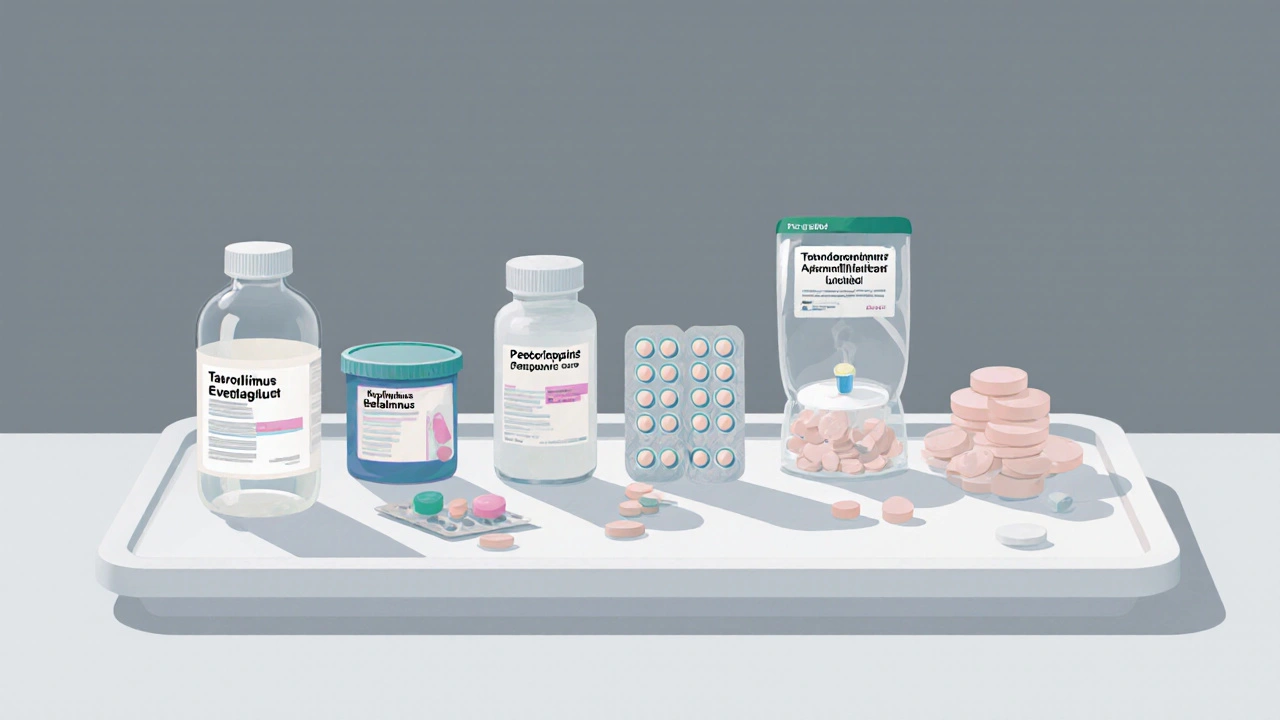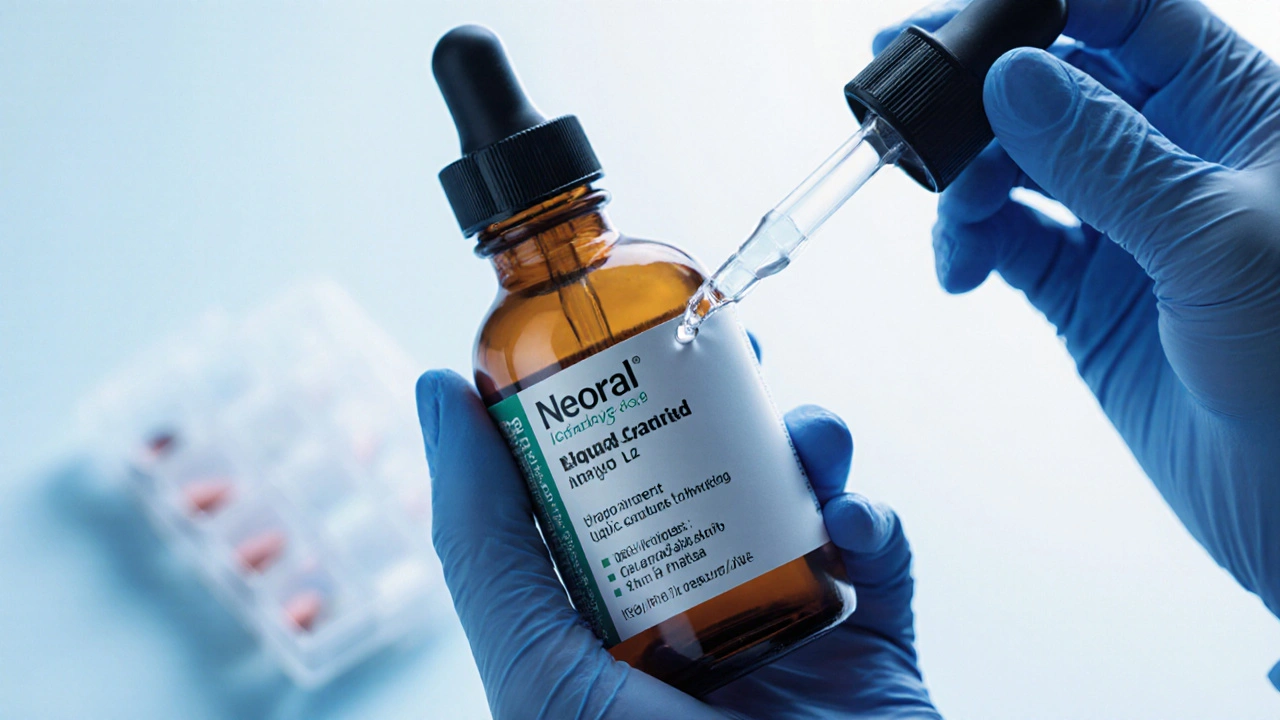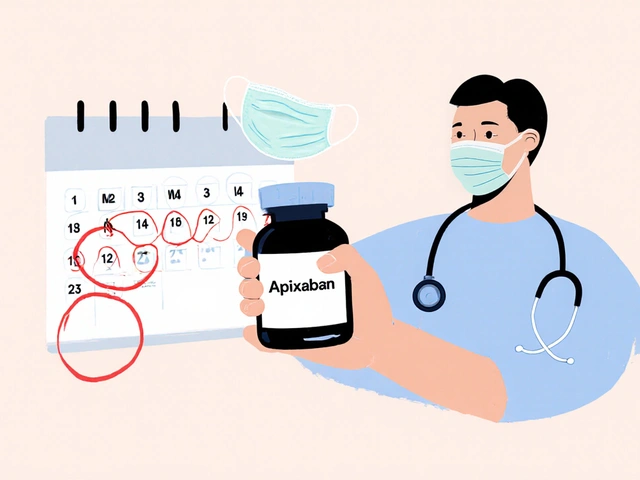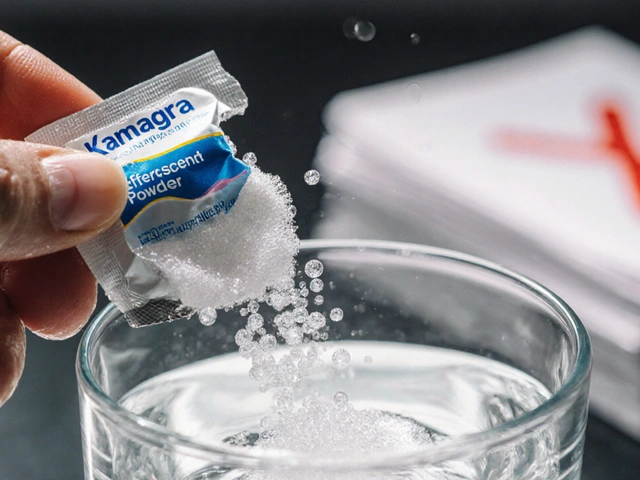Immunosuppressant Comparison Tool
Find Your Best Immunosuppressant Option
This tool helps you compare immunosuppressants based on your specific health needs. Select your primary concern and enter relevant details to get personalized recommendations.
If you or a loved one are on Neoral and wonder whether another drug might fit better, you’re not alone. Transplant patients, dermatologists, and rheumatologists all weigh the pros and cons of different immunosuppressants every day. This guide breaks down Neoral, its main competitors, and the factors that matter when choosing the right regimen.
Key Takeaways
- Neoral is a brand of cyclosporine that offers a once‑daily, liquid formulation designed for steady blood levels.
- Top alternatives include tacrolimus, mycophenolate mofetil, sirolimus, everolimus, belatacept, azathioprine, and prednisone.
- Decision points focus on side‑effect profile, kidney function, drug‑interaction risk, and cost.
- Switching drugs requires careful monitoring of blood levels and may need a short overlap period.
- Consult your transplant team or specialist before making any changes.
What is Neoral?
Neoral is a branded, micro‑emulsion formulation of cyclosporine A, an immunosuppressant that blocks T‑cell activation. First approved in 1994, Neoral was created to improve the erratic absorption seen with older cyclosporine products.
How Neolar Works
Cyclosporine binds to the intracellular protein cyclophilin, forming a complex that inhibits calcineurin. This stops the production of interleukin‑2, a key signal that tells T‑cells to multiply. The result is a dampened immune response, which prevents organ rejection and helps control severe autoimmune skin conditions.

Top Alternatives to Neoral
Most alternatives belong to the same class of calcineurin inhibitors or act on different pathways altogether. Below is a quick snapshot of each option.
Generic Cyclosporine (Sandimmune)
Sandimmune is the original oral cyclosporine capsule. It’s less expensive than Neoral but requires twice‑daily dosing and shows greater variability in blood levels, which can increase rejection risk.
Tacrolimus (Prograf)
Tacrolimus works on the same calcineurin pathway but is about 100‑times more potent than cyclosporine. It’s typically taken twice a day, though an extended‑release version (Envarsus) allows once‑daily dosing.
Mycophenolate Mofetil (CellCept)
Mycophenolate blocks the enzyme inosine monophosphate dehydrogenase, halting the proliferation of B‑ and T‑cells. It’s often paired with a calcineurin inhibitor for a synergistic effect and is taken twice daily.
Sirolimus (Rapamune)
Sirolimus (also known as rapamycin) inhibits the mammalian target of rapamycin (mTOR), a different checkpoint in cell growth. It’s less nephrotoxic than cyclosporine but can raise cholesterol and triglyceride levels.
Everolimus (Zortress)
Everolimus is a derivative of sirolimus with a shorter half‑life, allowing once‑daily dosing. It’s approved for kidney transplants and some cancer indications.
Belatacept (Nulojix)
Belatacept is a fusion protein that blocks the CD28‑CD80/86 co‑stimulatory signal needed for T‑cell activation. It’s given via monthly IV infusion and is kidney‑friendly but can raise infection risk.
Azathioprine
Azathioprine is a purine analog that interferes with DNA synthesis in rapidly dividing cells, including lymphocytes. It’s inexpensive and taken once daily but may cause bone‑marrow suppression.
Prednisone (Corticosteroid)
Prednisone provides broad anti‑inflammatory effects and is often used in the early post‑transplant period. Long‑term use leads to weight gain, bone loss, and glucose intolerance.
Side‑Effect Profiles at a Glance
| Drug | Brand (if any) | Typical Dose Frequency | Half‑life (hrs) | Nephrotoxicity | Common Side‑effects | Monitoring Needed | Approx. Annual Cost (USD) |
|---|---|---|---|---|---|---|---|
| Cyclosporine (Neoral) | Neoral | Once daily | 6‑12 | Moderate | Hypertension, gum hyperplasia, tremor | Blood trough level (C0), kidney function | ~$9,000 |
| Cyclosporine (Generic) | Sandimmune | Twice daily | 6‑12 | Moderate | Kidney toxicity, hirsutism | Blood trough level, kidney function | ~$3,500 |
| Tacrolimus | Prograf / Envarsus | Twice daily (once daily for Envarsus) | 12‑18 | Low‑moderate | Neurotoxicity, diabetes, hyperkalemia | Blood trough level, glucose, kidney function | ~$7,200 |
| Mycophenolate Mofetil | CellCept | Twice daily | 16‑18 | Low | GI upset, leukopenia | CBC, liver enzymes | ~$4,800 |
| Sirolimus | Rapamune | Once daily | 60 | Low | Hyperlipidemia, delayed wound healing | Blood level, lipid panel | ~$6,500 |
| Everolimus | Zortress | Once daily | 30 | Low | Stomatitis, infections | Blood level, renal function | ~$7,000 |
| Belatacept | Nulojix | Monthly IV | - (biologic) | Kidney‑friendly | Infections, PTLD risk | Clinical monitoring, EBV status | ~$12,000 |
| Azathioprine | - | Once daily | 5‑6 | Low | Bone‑marrow suppression, liver enzymes | CBC, liver enzymes | ~$2,000 |
| Prednisone | - | Once daily (taper) | 3‑4 | Low | Weight gain, hypertension, glucose rise | Blood glucose, blood pressure | ~$500 |
How to Choose the Right Option
Think of the decision like a checklist you’d use before buying a car: you weigh performance, fuel cost, safety, and how it fits your daily routine. Here are the core criteria for immunosuppressants:
- Kidney safety: If you already have reduced kidney function, tacrolimus or belatacept might be gentler than cyclosporine.
- Side‑effect tolerance: Some patients can’t handle cyclosporine‑related tremors, so they switch to mycophenolate or sirolimus.
- Drug‑interaction load: Cyclosporine interacts with many antibiotics and statins; tacrolimus has a similar profile but fewer cosmetic side‑effects.
- Dosing convenience: Once‑daily options (Neoral, Envarsus, everolimus) improve adherence compared to twice‑daily regimens.
- Cost & insurance coverage: Generic cyclosporine and azathioprine are the cheapest, while biologics like belatacept can top $12k annually.
- Clinical scenario: Early post‑transplant patients often start with a combo of tacrolimus + mycophenolate + steroids, then taper steroids.

Pros and Cons at a Glance
| Drug | Pros | Cons |
|---|---|---|
| Neoral (Cyclosporine) | Once‑daily dosing, well‑studied, suitable for many transplants. | Nephrotoxic, variable absorption, higher cost than generic. |
| Generic Cyclosporine (Sandimmune) | Cheaper, same mechanism. | Twice‑daily dosing, more blood‑level swings. |
| Tacrolimus | More potent, lower nephrotoxicity, good for kidney transplants. | Higher diabetes risk, neurotoxicity, requires close monitoring. |
| Mycophenolate Mofetil | Low kidney impact, synergistic with calcineurin inhibitors. | GI upset, leukopenia, not a standalone for high‑risk patients. |
| Sirolimus | Kidney‑friendly, anti‑viral benefits. | Delays wound healing, raises lipids. |
| Everolimus | Once‑daily, useful when mTOR inhibition is needed. | Stomatitis, infections. |
| Belatacept | Very low nephrotoxicity, monthly infusion. | IV requirement, infection and PTLD risk, pricey. |
| Azathioprine | Cheap, oral, long‑track record. | Bone‑marrow suppression, less potent. |
| Prednisone | Fast‑acting, inexpensive. | Long‑term side‑effects (weight, bone loss, glucose). |
Switching from Neoral to Another Agent
Changing immunosuppression isn’t a DIY project. Here’s a typical step‑by‑step plan doctors follow:
- Baseline labs: Check kidney function (eGFR), liver enzymes, CBC, and current cyclosporine trough level.
- Choose the new drug: Base the selection on the criteria above and patient preferences.
- Overlap period: Start the new medication at a low dose while keeping Neoral for 3‑7 days, then taper Neoral.
- Monitor closely: After the switch, check drug levels (if applicable) at days 3, 7, and 14, plus routine labs.
- Adjust dose: Fine‑tune based on therapeutic windows and side‑effect profile.
- Patient education: Explain new dosing schedule, possible side‑effects, and when to call the clinic.
Never stop Neoral abruptly; sudden loss of immunosuppression can trigger acute rejection.
Frequently Asked Questions
Can I take tacrolimus and mycophenolate together?
Yes, the combination is common for kidney and liver transplants. Tacrolimus handles calcineurin inhibition while mycophenolate adds anti‑proliferative power. Your doctor will monitor blood levels and white‑blood‑cell counts closely.
Is Neoral more effective than generic cyclosporine?
Clinical studies show similar efficacy when blood levels are matched. Neoral’s advantage is steadier absorption, which can make dosing easier, especially for patients who struggle with twice‑daily schedules.
What should I do if I develop gum overgrowth on Neoral?
Gum hyperplasia is a known side‑effect. Good oral hygiene helps, but many clinicians switch to tacrolimus or add a dental referral if it becomes severe.
Are there any natural supplements that interfere with cyclosporine?
Yes. St.John’s wort, grapefruit juice, and high‑dose vitaminE can raise cyclosporine levels and increase toxicity. Always tell your pharmacist about supplements.
How often should I get blood tests after switching to belatacept?
Because belatacept is a biologic, you won’t monitor drug levels, but you should have CBC, kidney function, and EBV PCR monthly for the first six months, then every 3months.
Next Steps
If you’re thinking about changing from Neoral, schedule a visit with your transplant pharmacist or physician. Bring a list of all current meds, recent lab results, and any side‑effects you’ve noticed. Together you can map out a transition plan that keeps your graft safe and your quality of life high.
Remember, every immunosuppressant carries risks. The best choice balances effectiveness, side‑effect tolerance, convenience, and cost. Keep the conversation open with your health team, and don’t hesitate to ask for a written comparison chart-your doctor can personalize the numbers for you.







Steven Elliott
October 13, 2025 AT 18:38Sure, because everyone loves juggling blood levels like a circus act; maybe the next step is to prescribe a daily dose of optimism.
Lawrence D. Law
October 23, 2025 AT 00:52While it is evident-upon thorough examination of the pharmacoeconomic data-that Neoral presents a cost‑benefit profile inferior to generic alternatives, one must nevertheless acknowledge the unparalleled dedication required to maintain therapeutic trough levels, especially given the drug's narrow therapeutic window; thus, the recommendation stands: consider substitution only after exhaustive assessment.
Odin Zifer
November 1, 2025 AT 07:05They don’t want you to know that the pharma giants are secretly embedding microchips in the capsules to monitor your kidney function while they sell you overpriced versions of the same molecule
Marisa Leighton
November 10, 2025 AT 13:18When it comes to choosing an immunosuppressant, the first thing to remember is that your health is the ultimate adventure.
Neoral may look shiny, but there are dozens of alternatives that can match or exceed its efficacy.
Take tacrolimus, for example, a powerhouse that often outperforms cyclosporine in kidney graft survival.
Its once‑daily formulation, especially Envarsus, eliminates the hassle of splitting doses.
Side‑effects such as neurotoxicity are manageable with dose adjustments and regular monitoring.
Mycophenolate, on the other hand, offers a gentle profile for the bone marrow while teaming up perfectly with calcineurin inhibitors.
If you dread gum overgrowth, switching to sirolimus or everolimus can spare you that unsightly side‑effect.
Belatacept might sound intimidating, but its monthly IV infusion dramatically reduces nephrotoxicity.
Cost concerns are real, yet many insurance plans cover the cheaper generics like azathioprine without sacrificing outcomes.
Remember that adherence is king-once‑daily options dramatically improve compliance compared to twice‑daily regimens.
The transition process is not a DIY project; always involve your transplant team to avoid acute rejection.
Laboratory monitoring, especially trough levels, remains crucial during any switch.
Educate yourself about drug‑drug interactions: cyclosporine loves to play nicely with statins, often too nicely.
Ultimately, the goal is a balanced regimen that protects your graft while preserving quality of life.
Stay optimistic, stay informed, and never hesitate to ask your doctor for a personalized comparison chart.
Chelsea Hackbarth
November 19, 2025 AT 19:32Here's the quick math: Neoral ≈ $9k/year, generic cyclosporine ≈ $3.5k, tacrolimus ≈ $7.2k, mycophenolate ≈ $4.8k. 📊💊 The cheaper options still require meticulous level checks, though.
Adam Shooter
November 29, 2025 AT 01:45From a pharmaco‑kinetic standpoint, Neoral's variable bioavailability introduces a coefficient of variance that eclipses the stability index of tacrolimus, rendering its therapeutic window precariously narrow and necessitating high‑frequency pharmacodynamic monitoring to mitigate nephrotoxic risk.
Shanmughasundhar Sengeni
December 8, 2025 AT 07:58Honestly, the whole tool feels like a glorified spreadsheet; just ask your doctor and you're done.